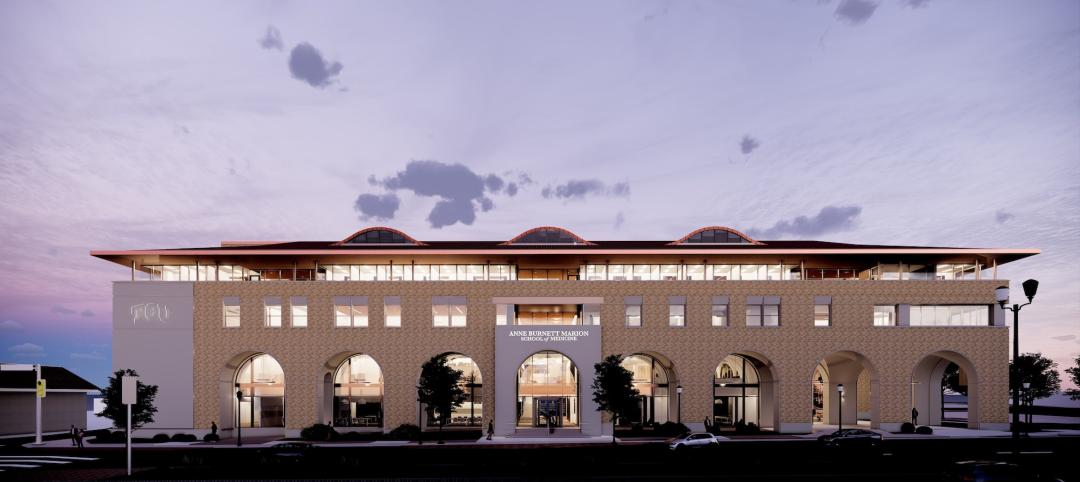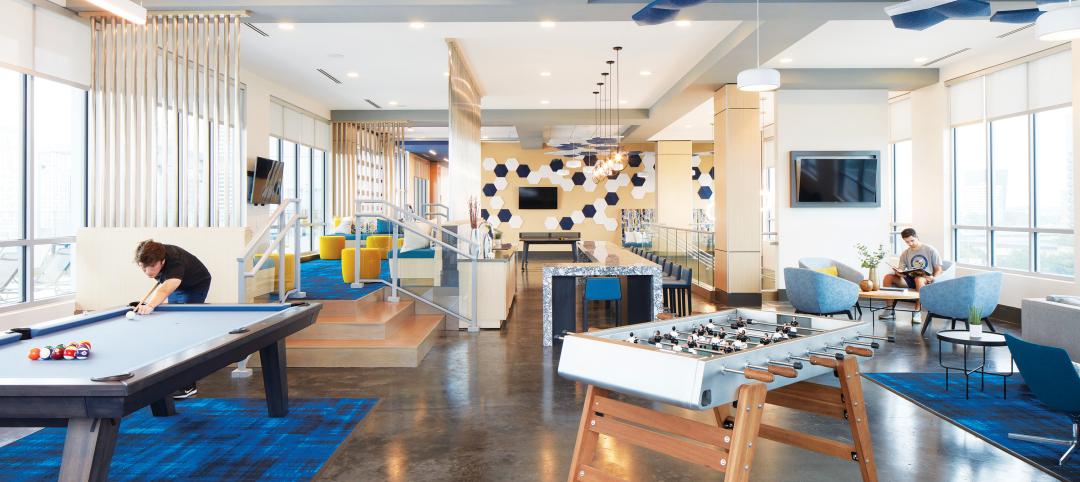On Monday, Columbia University held a dedication ceremony for its 17-acre Manhattanville campus in the West Harlem section of New York City. This $6.3 billion campus, which when completed will comprise 6.8 million sf of new academic space, is the university’s most ambitious expansion since it relocated to its current campus at Morningside Heights in Harlem 119 years ago.
The new campus, which was master planned by Skidmore Owings & Merrill and Renzo Piano Building Workshop, has been in the works since 2003, roughly around the time Lee C. Bollinger became the university’s president. “We knew that Columbia had to have new space to fulfill its mission as a great university,” said Bollinger during the dedication’s luncheon, held inside the 450,000-sf Jerome L. Greene Science Center, Manhattanville’s first building to open.
The Center, which should be fully occupied by next spring, is home to the Mortimer B. Zuckerman Mind Brain Behavior Institute. (The publisher and philanthropist Mort Zuckerman; Christina McInerney, president and CEO of the Jerome L. Greene Foundation; three Nobel Prize laureates and two Pulitzer Prize winners were among the dignitaries in attendance.)
Over the next two years, the Manhattanville campus will open the 60,000-sf Lenfest Center for the Arts, which will feature the Miriam and Ira D. Wallach Art Gallery, a 150-seat screening room, and a 4,300-sf presentation space; and the 56,000-sf University Forum, with a 430-seat auditorium.
Eric Kandel, MD, co-director of the Zuckerman Mind Brain Institute (and a Nobel Laureate in 2002 for the category physiology or medicine), proclaimed this project “historically important” to the university’s stature as well as for accentuating the symbiosis on campus between “bioscience and the arts.”
By 2021, the Ronald O. Perlman Center for Business Innovation and the Henry Kravis Building—492,000 sf across two buildings designed by Diller Scofidio + Renfro in collaboration with FXFowle Architects—will be the new home for the Columbia Business School.
Architect Renzo Piano describes the Jerome L. Greene Science Center in relation to its surrounding environment, which includes New York City's West Side Highway and the Hudson River. Image: BD+C
Architect Renzo Piano spoke at the dedication, at which he referred to the Jerome L. Greene Science Center as both a “palace” and a “factory that explores the secrets of the mind.” Piano also talked about the “urban layer” that will connect the campus to the community via reversed ground-floor setbacks, widened sidewalks, the absence of walls or gates (which is in marked contrast to the fortress-like Morningside Heights campus), height limitations (the Center is nine stories above ground), and a custom-glazed curtainwall.
His firm designed the Center to be as transparent as possible. The facility’s first floor, in fact, is open to the public. And its offices, labs, and other workspaces are organized on an open floor plan, divided into quadrants along North-South/East-West axes that expose workers and visitors to ample daylight.
Jerome L. Greene Science Center is across the street from an elevated subway line whose noise level measures 88 decibels. To mitigate that noise, the building was designed with a double-pane glass wall system whose 16-inch-wide air cavity in between exhausts air from the HVAC system and lets occupants open windows and glass doors from the inside. Open-air staircases connect the floors and encourage interaction between departments.
A 75,000-sf central energy plant, beneath the Greene and Lenfest buildings, will deliver electricity, chilled water, and high-pressure steam to nearly all of the buildings on campus.
The exterior bracing is visible to call attention to Greene’s “industrial” affinity with surrounding buildings in the neighborhood. That connection is reinforced by Columbia’s adaptive reuse of existing buildings on Manhattanville’s campus—specifically a one-time Studebaker auto-manufacturing plant and milk processing plant—that now serve, respectively, as university administration offices and Columbia’s center for the study of jazz and computer-generated music.
Manhattanville was the original name of this neighborhood, and Columbia and its AEC partners are at great pains to position this campus expansion as integral to a community that in the past has been wary about the university’s growth intentions. Bollinger, in his comments, went so far as to state that the new campus “is the best thing that could happen to upper Manhattan.”
Outdoor plazas within the campus will be accessible to the general public. The Jerome L. Greene Science Center will include a 1,920-sf Wellness Center that conducts free programs to raise awareness about stroke and related risk factors, and trains local residents to become community health workers. The Wellness Center will also be home to Mental Health First Aid, a program dedicated to improving the quality of mental health services in Upper Manhattan.
A 1,500-sf Education Lab within the Center will provide programs about brain science for the community and K-12 schools. Columbia has contracted with BioBus, an independent nonprofit, to run this program, and to bring learning into the community.
“This campus puts Columbia into the world,” observed Marilyn Jordan Taylor, a consulting partner with SOM (where she spent 33 years) and the former dean of the University of Pennsylvania’s School of Design.
Columbia|Manhattanville’s buildings are targeting LEED Platinum ND certification. Lendlease and McKissack Construction are the construction managers on the Greene and Lenfest buildings, Skanska and Velez Organization are the CMs on the University Forum building. And Turner will be the CM on the business school.
Related Stories
University Buildings | Jan 17, 2023
Texas Christian University breaks ground on medical school for Dallas-Fort Worth region
Texas Christian University (TCU) has broken ground on the Anne Burnett Marion School of Medicine, which aims to help meet the expanding medical needs of the growing Dallas-Fort Worth region.
ProConnect Events | Jan 16, 2023
6 more BD+C ProConnect Events in 2023 – The videos show why you should participate
ProConnects bring building product manufacturers and suppliers together with architects, contractors, builders, and developers to discuss upcoming projects and learn about new products and technical solutions.
Adaptive Reuse | Jan 12, 2023
Invest in existing buildings for your university
According to Nick Sillies of GBBN, students are increasingly asking: "How sustainable is your institution?" Reusing existing buildings may help answer that.
University Buildings | Dec 22, 2022
Loyola Marymount University completes a new home for its acclaimed School of Film and Television
California’s Loyola Marymount University (LMU) has completed two new buildings for arts and media education at its Westchester campus. Designed by Skidmore, Owings & Merrill (SOM), the Howard B. Fitzpatrick Pavilion is the new home of the undergraduate School of Film and Television, which is consistently ranked among the nation’s top 10 film schools. Also designed by SOM, the open-air Drollinger Family Stage is an outdoor lecture and performance space.
Adaptive Reuse | Dec 21, 2022
University of Pittsburgh reinvents century-old Model-T building as a life sciences research facility
After opening earlier this year, The Assembly recently achieved LEED Gold certification, aligning with the school’s and community’s larger sustainability efforts.
Sponsored | Resiliency | Dec 14, 2022
Flood protection: What building owners need to know to protect their properties
This course from Walter P Moore examines numerous flood protection approaches and building owner needs before delving into the flood protection process. Determining the flood resilience of a property can provide a good understanding of risk associated costs.
Adaptive Reuse | Dec 9, 2022
What's old is new: Why you should consider adaptive reuse
While new construction allows for incredible levels of customization, there’s no denying that new buildings can have adverse impacts on the climate, budgets, schedules and even the cultural and historic fabrics of communities.
Student Housing | Dec 7, 2022
9 exemplary student housing projects in 2022
Production continued apace this year and last, as colleges and universities, for-profit developers, and their AEC teams scrambled to get college residences open before the start of classes.
Student Housing | Dec 7, 2022
Cornell University builds massive student housing complex to accommodate planned enrollment growth
In Ithaca, N.Y., Cornell University has completed its North Campus Residential Expansion (NCRE) project. Designed by ikon.5 architects, the 776,000-sf project provides 1,200 beds for first-year students and 800 beds for sophomore students. The NCRE project aimed to accommodate the university’s planned growth in student enrollment while meeting its green infrastructure standards. Cornell University plans to achieve carbon neutrality by 2035.
University Buildings | Dec 5, 2022
Florida Polytechnic University unveils its Applied Research Center, furthering its mission to provide STEM education
In Lakeland, Fla., located between Orlando and Tampa, Florida Polytechnic University unveiled its new Applied Research Center (ARC). Designed by HOK and built by Skanska, the 90,000-sf academic building houses research and teaching laboratories, student design spaces, conference rooms, and faculty offices—furthering the school’s science, technology, engineering, and mathematics (STEM) mission.















